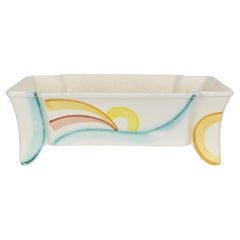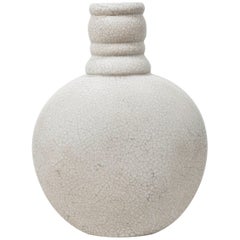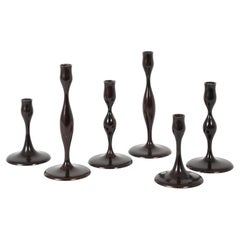Eva Zeisel Planters, Cachepots and Jardinières
to
1
1
1
1
1
1
1
1
1
1
1
Height
to
Width
to
1
1
1
7
43
31
29
27
Creator: Eva Zeisel
Bauhaus Era Ceramic Bonsai Planter by Eva Zeisel Schramberg Art Deco Avantgarde
By Schramberg Majolica, Eva Zeisel
Located in Bad Säckingen, DE
This exceptional Bauhaus era ceramic bonsai planter or cachepot was designed by the renowned designer Eva Zeisel and produced by the Schramberger Majolika Manufaktur (SMF) in Germany...
Category
1920s German Art Deco Vintage Eva Zeisel Planters, Cachepots and Jardinières
Materials
Ceramic, Majolica
Related Items
French Art Deco Ceramic Vase by Primavera
By Atelier Primavera au Printemps
Located in Paris, FR
French white craquelure vase by Charlotte Chauchet (1878-1964)
for Atelier Primavera au Printemps
Signed Primavera, France,
Numbered.
Category
1930s French Art Deco Vintage Eva Zeisel Planters, Cachepots and Jardinières
Materials
Ceramic
Set of Eva Zeisel Candlesticks, USA 2007
By Eva Zeisel
Located in New York, NY
Rare set of Bronze candlesticks by Eva Zeisel in 2007 at 101 years of age, this is the complete set of sizes at 6”, 8” and 11”, From the “Originals” line, signed to base and no longe...
Category
21st Century and Contemporary American Modern Eva Zeisel Planters, Cachepots and Jardinières
Materials
Bronze
French Art Deco Ceramic Vase or Small Planter
Located in Miami, FL
This dazzling glazed French Art Deco ceramic vase or small planter was handcrafted. The mixture of colors are truly beautiful.
It can...
Category
Early 20th Century French Art Deco Eva Zeisel Planters, Cachepots and Jardinières
Materials
Ceramic, Pottery
1940 Vintage Roseville Art Pottery Green Ming Tree 568-8 Rare Bonsai Planter
By Roseville Pottery
Located in San Gabriel, CA
Roseville Ming Tree Green 1949 Mid Century Art Pottery Window Box Planter 568-8. Very good condition. Bottom marked with Roseville, USA and shape number. No chips but very slight gra...
Category
1940s American Art Deco Vintage Eva Zeisel Planters, Cachepots and Jardinières
Materials
Ceramic
$175
H 4 in W 8 in D 1.75 in
Italian Art Déco style Black & White Ceramic Planters
Located in Greenwich, CT
Pair of stylish 1950's Italian Art Déco style Ceramic Planters
of black and white horizontal bands decor,
each planter approx. 13" W, 11 ½ " H , with handles
Highly decorati...
Category
1950s Vintage Eva Zeisel Planters, Cachepots and Jardinières
Materials
Ceramic, Pottery
Rare 1950s Eva Zeisel Stoneware Bird Teapot Mid-Century Figural Vessel
By Eva Zeisel
Located in Hyattsville, MD
Early design, whimsical! A bird-form teapot with winged lid, Monmouth Pottery, via Pine Stoneware or Western Stoneware Company in Monmouth, Illinois....
Category
1950s American Mid-Century Modern Vintage Eva Zeisel Planters, Cachepots and Jardinières
Materials
Ceramic
$2,175
H 6.75 in W 8.5 in D 6.5 in
DENBAC French Art Deco Stoneware Planter, 1910s
By Denbac
Located in Saint-Amans-des-Cots, FR
Large French Art Deco stoneware planter by DENERT & BALICHON (Vierzon), France, 1910s. Height : 9.25"(23.5cm), Diameter : 11.8"(30cm). Signed "Denbac" and numbered 122 under the base...
Category
1910s French Art Deco Vintage Eva Zeisel Planters, Cachepots and Jardinières
Materials
Stoneware
Art Nouveau ceramic vase from Schramberg. 1900 - 1920
Located in CADALSO, ES
Great condition
Category
Early 20th Century German Art Nouveau Eva Zeisel Planters, Cachepots and Jardinières
Materials
Ceramic
Eva Zeisel Art Deco Bauhaus Pottery Vase, SMF Schramberg, Germany 1920s
By Schramberg Majolica, Eva Zeisel
Located in Vienna, AT
A colorful and charming Majolica pottery vase from the German modernist Bauhaus era, designed in the late 1920s by Eva Zeisel for the Schramberg Majolika Fabrik (SMF) in Germany. Han...
Category
1920s German Bauhaus Vintage Eva Zeisel Planters, Cachepots and Jardinières
Materials
Ceramic, Pottery
Small Vintage Planter, Chinese, Ceramic, Jardiniere, Art Deco, Mid Century, 1940
Located in Hele, Devon, GB
This is a small vintage planter. A Chinese, ceramic jardiniere in late Art Deco taste, dating to the mid 20th century, circa 1940.
Pleasingly diminutive, ideal for displaying in a window
Displays a desirable aged patina and in good original order
White ground finished in a bulb form with broad rim
Accentuated with a light blue transfer print...
Category
Mid-20th Century Chinese Mid-Century Modern Eva Zeisel Planters, Cachepots and Jardinières
Materials
Ceramic
$693
H 6.11 in W 7.88 in D 7.88 in
Art Deco Walnut Planter / Waste Paper Bin
Located in London, GB
A very stylish and rare Art Deco walnut planter / waste paper bin. This was made in England, it dates from the 1930’s.
This is beautifully made from walnut, it has a removable metal...
Category
1930s British Art Deco Vintage Eva Zeisel Planters, Cachepots and Jardinières
Materials
Walnut
Vintage Grete Marks Art Deco Bauhaus Turquoise, Royal Blue Ceramic Vessel, Vase
By Margarete Heymann
Located in North Miami, FL
This very rare hallmarked Art Deco ceramic bowl and or vase is by the infamous Grete Marks from the 1930s. She was born Margarete Heyman in Cologne Germany...
Category
1930s German Art Deco Vintage Eva Zeisel Planters, Cachepots and Jardinières
Materials
Ceramic
$1,430 / item
H 6 in W 7.5 in D 7.5 in
Eva Zeisel planters, cachepots and jardinières for sale on 1stDibs.
Eva Zeisel planters, cachepots and jardinières are available for sale on 1stDibs. These distinctive items are frequently made of majolica and are designed with extraordinary care. Many of the original planters, cachepots and jardinières by Eva Zeisel were created in the Art Deco style in germany during the 1920s. Prices for Eva Zeisel planters, cachepots and jardinières can differ depending upon size, time period and other attributes — on 1stDibs, these items begin at $1,625 and can go as high as $1,625, while a piece like these, on average, fetch $1,625.


